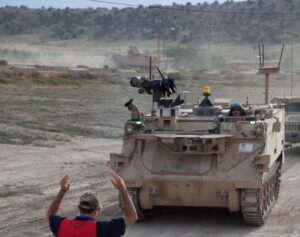The Army on Thursday detailed lessons learned to date in its Robotic Combat Vehicle (RCV) effort, including mission payloads that will be required for the future fleet and a call for new capabilities to further reduce the cognitive burden of the robots’ human operators.
Army officials told attendees during a virtual NDIA event the data and feedback gathered from the Phase 1 RCV experiment this summer and multiple virtual tests is an opportunity for industry to inform potential offerings beyond the program’s prototyping phase.

“What we’ve learned in the past is that we tend to get a much better product in the end if we are very transparent with industry, as opposed to holding everything tight to our vest and then hoping that something shakes out great when we hand them our requirements document,” said Maj. Cory Wallace, a lead official for RCV. “There’s a lot we have to figure out [with RCV]. One could argue that the last time the Army did something this revolutionary where we’re trying to integrate a new piece of equipment with a new type of way that doesn’t exist was either the [introduction] of the helicopter or the tank.”
Wallace also stressed the importance of future RCV partners bringing an entirely domestic supply chain for their work, to avoid potential for adversarial cyber intrusions.
“We understand how hard it’s going to be getting to pure domestic foundries. But, if you look at the past with all the cyber attacks that we’ve had in the force in the past two or three years, you can look at smuggling a zero-day attack in something as small as a resistor,” Wallace said.
The Army has gathered an initial group of lessons the Army learned specifically from “multiple virtual experiments, tabletop exercises, leader engagement throughout the field,” to include proving out RCVs ability to reduce potential for human casualties during a simulation with a tank platoon.
“At the end of the day, when they fought pure tanks with humans every single vehicle was degraded to some extent, if not catastrophically destroyed. When we fought them with the RCVs, some of the control vehicles were somewhat degraded but, at the end of the day, there were no human casualties with the RCVs,” Wallace said.
The Army has also narrowed down a list of payloads that should be required for RCVs based on soldier feedback to cover counter-UAS capabilities, electronic warfare tools, breaching capabilities, 360-degree situational awareness that must include audio feed and chemical, biological, radiological, and nuclear detection.
From the Army’s Phase 1 RCV experiment, which concluded in August, Wallace said the Army was able to prove the ability to shoot, move and communicate with RCV but that it will require “the most advanced technology possible” to allow soldiers to operate the future vehicles without excessive cognitive burden.
“We know it can shoot, move and communicate but we don’t know for how long. We don’t know how long they can do those tasks before they just get burned out staring at a screen,” Wallace said. The five-week Phase 1 experiment this summer that took place at Fort Carson in Colorado was a platoon-level demonstration that used modified Bradleys as control vehicles and M113s as surrogate robots (Defense Daily, Aug. 6).
The RCV Phase 2 experiment will take place in early FY ‘22, and it will be a company-level demonstration involving the RCV-Light and RCV-Medium prototypes.
The Army in January awarded prototype deals to QinetiQ North America for RCV-L and a Textron [TXT] team for RCV-M, with each company tasked with delivering four test vehicles (Defense Daily, Jan. 9).